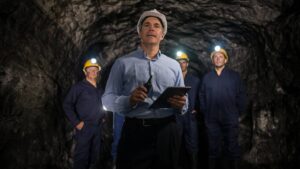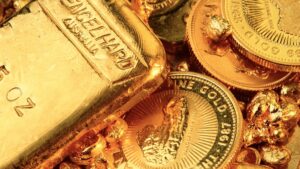RIU Sydney Resources Roundup: Why junior explorers need your backing to make net zero a reality

Pic: John Rensten/The Image Bank via Getty Images
Explorers, investors, analysts, bankers and more converging on Sydney for the 2023 edition of the RIU Sydney Resources Roundup have heard the fate of the world is in the hands of our junior resources companies.
In a wide-ranging keynote at the conference at Sydney’s Hyatt Regency yesterday, Euroz Hartleys resources analyst Michael Scantlebury laid out the massive challenge facing the energy sector in its efforts to replace fossil fuels with renewables without a major lift in the discovery and mining of critical minerals.
Scantlebury told delegates the net zero challenge was the “largest opportunity the resource sector has ever faced”.
“We’re trying to replace 80% of the global energy supply that is currently being supplied by coal, oil and gas with renewable energy,” he said. “Without a substantial increase in mining investment, there will be no energy transition.”
Hundreds of billions
Scantlebury says investment needed to build the renewable energy needed to transition from oil, gas and coal in a net zero world will need to be in the order of the half a trillion being spent by the latter to sustain production in the years to come.
Currently, mining capex is around a fifth of that level, with majors showing a preference for sustaining capex and M & A to grow production rather than developing new projects.
That has been reflected in the long term trend away from spending on greenfields exploration to near mine exploration at the world’s major mining houses, Scantlebury said.
“Despite the large increase in the copper exploration budget, the number of new resources discovered globally has been steadily declining over the last decade or decades as the most accessible and easiest discoveries have been already been made, the outcropping discoveries,” he said.
“We don’t see any change for this trend as well. This doesn’t only just apply to copper, but all commodities as well as discoveries become deeper and more remote and in challenging jurisdictions as well.
“Another explanation for this is around the shift in exploration budgets, as they move towards near mine and late stage exploration programs.
“Declining greenfield exploration has been a trend over the last 20 years. Only 20 years ago it was 50% of exploration budgets. Greenfield exploration is now down to just 16% of budgets, which goes a long way to explaining the lack of new discoveries.”
Without higher prices we are unlikely to see that reverse. If prices rise more marginal projects will come online.
That will itself provide support for higher prices with a higher marginal cost of production, with miners also needing to be wary of geological inflation caused by rising strip ratios and deeper hauling as mines get deeper, lower in grade and more difficult to develop.
Why juniors could be key to achieving net zero
Junior companies now make up almost 50% of the global exploration budget, signalling them as key protagonists in the hunt for the metals needed for our multi-generational renewable transition.
“Junior share of exploration has hit a 10-year high of close to 45%,” Scantlebury said.
“And we’re not surprised by this statistic as the nimble nature of junior companies, the cost effectiveness of juniors doing exploration over some of the majors can be orders of magnitude cheaper, which wouldn’t come as a surprise to many in the audience today.
“We believe that the junior sector needs to continue to increase exploration to continue to backfill and grow out those resource projects as we’ve shown that the metal demand is truly amazing over the coming years.
“We’re confident that the junior sector share of exploration budget will remain strong over the coming decade or decades provided the capital markets remain open.”
With that in mind, we caught a few of the junior superheroes making waves on the first day of Vertical Events’ RIU Sydney Resources Roundup.
The Sandman – VRX Silica (ASX:VRX)
VRX Silica boss Bruce Maluish wants to become the first major glassmaker in Western Australia.
VRX is one of the most advanced silica sands stocks in Australia, eyeing a 2023 start for its Arrowsmith North project 270km towards the equator from Perth, one of five in the development pipeline.
Located on WA’s Mid-West coast, the 2Mtpa operation is expected to yield $2.7 billion in revenue in its initial stage. With an additional 523Mt at 97.3% SiO2 at Arrowsmith Brand, also announced to the ASX yesterday morning, VRX has almost 1.4Bt in resources.
Its 221Mt ore reserve at 99.7% SiO2 at Arrowsmith North could support 100 years of production, Maluish said.
He says there’s been no glass manufacturing in WA for 50 years. That could change as Arrowsmith North matures.
“We’d like to be making ultra-clear glass in Western Australia. As it happens the ingredients for silica to make that glass you also need dolomite, lime, soda ash,” Maluish told delegates.
“Lime and dolomite we’ve got in Western Australia as well and with LNG we can produce soda ash. Also Western Australia is now the cheapest LNG in the world. So it’s a good place to be making glass.
“We’ve been talking to a number of the major glass producers in Asia to try and entice them to come down and build a glass plant. Our processing plant for the silica sand’s around 50 million bucks, glass plant $500 million.
“It’s a little bit out of our league, also we don’t have the IP in Australia, so we’d like to get somebody (a partner) there.”
VRX Silica (ASX:VRX) share price today:
The Black Panther — Leo Lithium (ASX:LLL)
Leo Lithium will be one of the closest watched stocks at the RIU Resources Roundup given its nearest comparison is making it look very cheap right now.
LLL owns 50% of the 500,000tpa Goulamina lithium project in Mali, Africa’s first spodumene mine being constructed in conjunction with China’s biggest lithium producer Ganfeng.
Leo is worth around $620 million on today’s market cap. Liontown Resources (ASX:LTR), which will open its roughly comparable in scale Kathleen Valley mine in WA at the same time in mid-2024, is worth $6.3 billion.
That, of course, is because they fielded a $2.50 per share bid from US lithium beast Albemarle, which has Liontown trading at $2.87 and a value which seemed unfathomable three months ago.
It’s a point not lost on Leo Lithium boss Simon Hay.
“You probably heard of Liontown. Liontown is on a very similar scale and schedule to us, first production mid next year, around about 150-160 million tonne resource, which is where we’ll be shortly,” he said.
“Just one little difference, their market cap is $6.2 billion, ours is $700 million. So even if you discount the 50% asset ownership you can really see on a resource level Leo Lithium is very undervalued.”
Despite a recent lift in capex, Hay says Leo plans to spend just US$318m to complete Goulamina, with 185,000t of DSO also planned to be sold to help offset those costs ahead of first concentrate, as soon as the fourth quarter of 2023.
“Total capex to bring us into production is US$318 million,” he said.
“And just to point out that gives us a capital intensity of US$563 per tonne SC6.
“Compared to some of our Australian counterparts who are dealing with different inflationary pressures, we’re roughly about a third of what it would cost to build a similar sized project here in Australia.
“So even though we have some disadvantages being in Africa, it certainly has some advantages on the capital cost side of things.”
Leo Lithium (ASX:LLL) share price today:
Shazam — Altech Batteries (ASX:ATC)
Lithium ion batteries, component metals and EVs are all the rage but Altech Batteries CFO Martin Stein says the company believes it will be able to make sodium-based batteries for grid storage 40% less costly than equivalent lithium ion batteries as it seeks to champion the development of solid state batteries.
“We’re ready to commercialise our joint venture which is 75% Altech, 25% (technology partner Fraunhofer),” Stein told delegates.
“This is the facility in Germany where Fraunhofer’s developed the battery ready for it to be commercialised. It’s a 35 million Euro pilot plant facility.
“We’re building or we’re commercialising a 100mW hour plant in Saxony in Germany on land that Altech’s got, 14 hectares. That’s the centre of EVs and battery technology in Germany.
“Fraunhofer estimates that the product will be 40% cheaper to produce because we use a sodium technology, we don’t use the expensive metals.
“We’re doing a bankable feasibility study that will be available at the end of the year, and that will confirm the costings of this but we expect them to be 40% cheaper than lithium ion batteries.”
Altech announced yesterday that two prototypes of its 60KWh (ABS60) battery pack are currently being produced and fabricated at the Fraunhofer IKTS facility in Hermsdorf, Germany.
Once completed, the battery packs will undergo cycling testing under extreme conditions, and they will be available for testing at customer premises.
Altech Batteries (ASX:ATC) share price today:
Booster Gold — Meeka Metals (ASX:MEK)
Meeka Metals boss Tim Davidson says a highly anticipated PFS on its 1Moz plus Murchison gold project is due next month, adding that the company feels its resource will grow larger still.
The gold and rare earths explorer has a share price of 3.9c and gained almost 15% yesterday on its highest grade clay rare earths results to date.
But its most advanced asset is the MGP, which Davidson believes is worth far more than its current market value.
Gold prices have lifted on recession fears and safe haven buying to near record levels in excess of US$2000/oz in recent weeks.
“If you look at what underpins the value of the business, it’s 1.2 million ounces — we feel it’s large — but 1.2 million ounces at a very high three grams per tonne global grade in the Murchison,” Davidson said.
“And if you value us on that resource alone, EV per resource ounce basis, it works out to be about $25 an ounce.
“Now we feel that’s a very low valuation given the quality of that resource, given the grade of that resource.
“It would be very difficult to go and drill out a resource of that size and that grade for $25 an ounce so there’s a compelling valuation purely on the resource and the EV per resource ounce metric.”
Previously owned and operated as the standalone Andy Well mine by Doray Minerals, a scoping study in December 2021 told a story of a return to production generating 443,000oz at an average all in sustaining cost of $1655/oz over an eight-year mine life, equivalent to around 50,000ozpa.
Meeka Metals (ASX:MEK) share price today:
At Stockhead, we tell it like it is. While Altech Batteries and Meeka Metals are Stockhead advertisers, they did not sponsor this article.
Related Topics

SUBSCRIBE
Get the latest breaking news and stocks straight to your inbox.
It's free. Unsubscribe whenever you want.
By proceeding, you confirm you understand that we handle personal information in accordance with our Privacy Policy.








